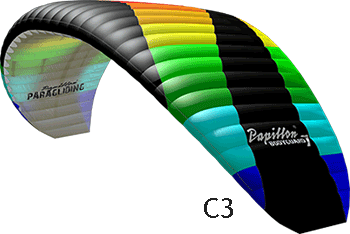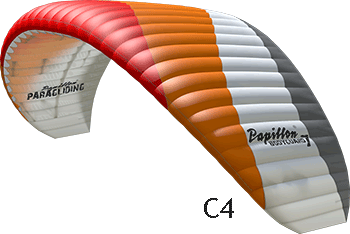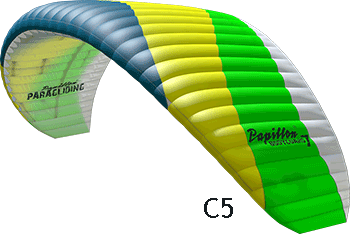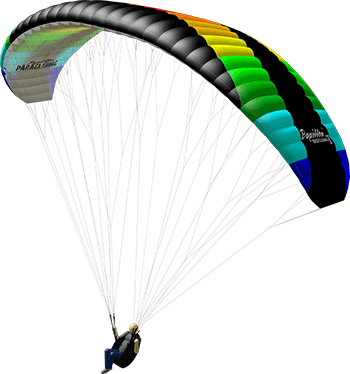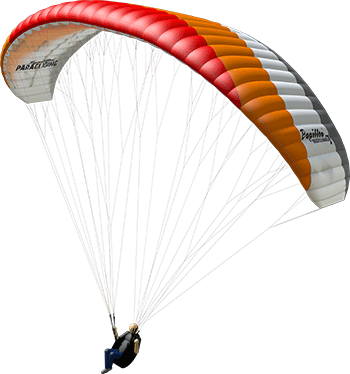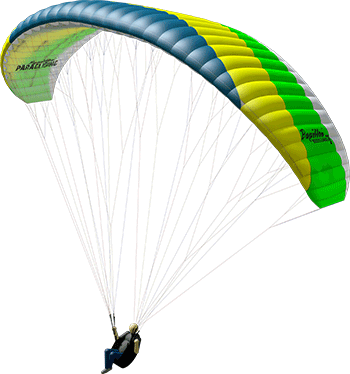Your reliable companion – right from the beginning!
The experience of Papillon Paragliding, Europe’s largest paragliding school went into the development of the Bodyguard 7. It unites all the features that allow you a safe and successful entry into the flight sport.
The name says it all. Those who trust this glider will always have a little bit more: more safety, more performance, more fun. Anyone who performs 100,000 flights with our students and pilots without incidents has our fullest confidence. Also as a hobby and leisure pilot the Bodyguard 7 will be a companion, you can rely on.
The BODYGUARD 7 combines sporty features with high passive safety. This makes it an ideal beginner’s glider, which guarantees fun and fast learning success long after training.
The BODYGUARD 7 is easy to launch. It climbs evenly and without any tendency to dive forward over the pilot and fills itself quickly and with little effort even in low wind. Even in turbulent air the BODYGUARD 7 can hardly be put out of control.
Even in weak thermals, it climbs efficiently and its direct handling helps to center the thermals.
The Bodyguard 7 is a paraglider of the latest generation and is equipped with numerous technical features: PPN and 3D shaping ensure an optimized inflow and dimensional stability of the leading edge. Complex calculations of the ballooning in combination with the optimized wing pre-stressing ensure a balanced pressure distribution and flow around the profile. Mini-ribs at the rear end of the wing give the profile more form fidelity and optimize the aerodynamics additionally, especially when braking. The High Pressure Crossport Design (HPCD) ensures optimized cross-ventilation of the cross ports and thus a balanced inside pressure of the wing, which further enhances safety.
A straightforward line concept with just a few main lines ensures easy handling and a good overview for ground handling. The risers are equipped with the Pilot Assistant (PAS) – colour markings and icons provide a better orientation of the line levels. In addition, the main suspensions are colour coded for better orientation.
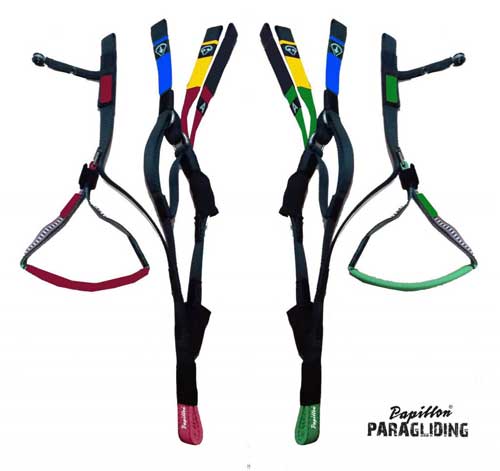 Better Orientation
Better Orientation
The risers are equipped with the Pilot Assistant (PAS) – colour markings and icons provide a better orientation of the line levels. In addition, the main suspensions are colour coded for better orientation.
Newest Paragliding Development





- Besides the PPN, the 3D shaping is providing optimized inflow and form stability of the cell opening area.
- Elaborate calculations of the ballooning in combination with the optimized pre-tensioning of the wing provide a balanced pressure distribution and circulation of the profile.
- Mini-ribs at the rear end of the wing give the profile more form fidelity and optimize the aerodynamics additionally, especially when braking.
- The High Pressure Crossport Design (HPCD) provides an ideal aeration of the crossports, which helps to balance the pressure differences on the inside of the wing, and therefore enhances the safety.
- Manufacturer
- Papillon Paragliders
- EN
- A
 Andreas Schubert about the Bodyguard 7
Andreas Schubert about the Bodyguard 7
The BODYGUARD 7 is the latest development in the upper EN-A segment. The balanced flight and material characteristics distinguish it as a particularly well-suited companion from the first high altitude flights to thermal flying and the first cross country experiences. Thanks to the lightweight fabric, its launch and reverse launch characteristics are definitely among the best and easiest in paragliding. At the same time, the leading edge and upper canopy are robust through the use of 5g/m2 heavy fabric and therefore also suitable for training or frequent groundhandling.
Glide performance of the B-Class
In the air the BODYGUARD 7 impresses with a glide ratio that until 2015 marked the B-Class. In thermals it turns flat with very little sinking and without dipping away. This is confirmed by the test pilots, who have been the highest in the test areas at all times. The reason for this is the reduction of the minimum sink rate by 0.1 m/s due to a larger surface area of approximately 2 square meters, which improves the climb performance by around 10% compared to most other gliders of almost all classes. Its take-off speed is low, which is an enormous advantage in the alpine terrain with little wind. Landing is also much easier for beginners. The trim speed is 33 – 36 km/h – depending on the suspension weight – enough to safely fly against the wind in a difficult meteorological environment. When the wind is increasing or during cross country flights, the speed can be increased to 44 to 48 km/h, depending on the load, using the speed system.
Extreme flight conditions
Extreme flight conditions are also extremely rare and can occur practically only after weather-induced overburden. In principle, the profile of the canopy is considered to be one of the most stable so far (see DHV Safetyclass Emotion 3, (same profile)). Even if it did collapse, the wing reacted with low overall dynamics in countless tests. In collapses it turns away between 90° (and only with large collapses) up to a maximum of 180°, dives moderately forward and has got my personal best marks for collapses in the lower to medium weight range due to the low sink rate. Even simpler behaviour in collapses was only observed with lower performance paragldiers (see "Fluglehrerpraxistests Papillon"). Frontal collapses immediate re-open occurs after a moderate dive forward. All in all, the dynamic in frontal collapses is also low.
Rapid Descent Methods
The B-stable is reliable and easy to fly compared to its predecessor models Bodyguard 1 to 3. The wing tilts slightly backwards during the introductory phase, begins to sink and remains very stable, even with asymmetrical operation. The sink rate is slightly lower due to its larger surface area of 10 m/s compared to other models. The recovery is immediate without delay. The most common rapid descent method is using "Big Ears". The outer lines are very well marked. They allow a simple entry for relaxed flying with a higher descent rate, which can be increased from 2.5 m/ s to 3.5 m/s with the use of a speed system. The recovery is immediate. I have only flown the spiral with the BODYGUARD 7 a few times. The wing has comparatively longer lines, which leads to slightly higher centrifugal forces in the manoeuvre. Therefore, this manoeuvre is only acceptable with training. For sink rates above 10m/s, an active flying style is required for the recovery to avoid further turning. However, active flying is the basis for flying spirals, which are regarded as the most demanding rapid descent method. In the upper weight range, the glider is very manoeuvrable, which also means increased dynamics in all exceptional flight conditions due to the lower roll damping. Talented pilots can experience their first stalls, flightbacks, helis and sats on the BODYGUARD 7. I had great fun, because all manoeuvres remain slower and thus also suitable for older test pilots
| BODYGUARD 7 | XS 55 | S 60 | SM 80 | M 85 | L 100 | XL 120 |
|---|---|---|---|---|---|---|
| Start Weight [kg] | 55-70 | 60-85 | 80-95 | 85-105 | 100-120 | 120-140 |
| extended Start Weight [kg] | 55-80 | 60-95 | 80-110 | 85-115 | 100-130 | 120-150 |
| Motor start weight (LTF 23/05) | – | 90-108 | 108-130 | 117-140 | 125-150 | – |
| Flat Area [m²] | 23 | 25,5 | 28,5 | 30 | 31,5 | 35 |
| Projected Area [m²] | 19,119 | 21,197 | 23,691 | 24,938 | 26,184 | 29,51 |
| Flat Wingspan [m] | 10,724 | 11,292 | 11,937 | 12,247 | 12,55 | 13,323 |
| Projected Wingspan [m] | 8,273 | 8,711 | 9,209 | 9,449 | 9,682 | 10,278 |
| Flat AR | 5 | 5 | 5 | 5 | 5 | 5 |
| Projected AR | 3,58 | 3,58 | 3,58 | 3,58 | 3,58 | 3,58 |
| Chord: Center/ Wingtip [m] | 2,550 / 0,721 | 2,686 / 0,769 | 2,849 m / 0,805 | 2,913 m / 0,823 | 3,008 / 0,850 | 3,186 / 0,901 |
| V-Trim [km/h] | ~ 37-39 | ~ 37-39 | ~ 37-39 | ~ 37-39 | ~ 37-39 | ~ 37-39 |
| V-Max [km/h] | 52 + | 52 + | 52 + | 52 + | 52 + | 52 + |
| Bridle height [m] | 6,649 | 7,001 | 7,401 | 7,593 | 7,781 | 8,26 |
| Nr. of Cells | 36 | 36 | 36 | 36 | 36 | 36 |
| Glider Weight[kg] | 4,7 | 5,2 | 5,8 | 5,9 | 6,1 | 6,8 |
| Bridle Length[m] | 243 | 256 | 269 | 279 | 286 | 304 |
| Line Diameter [mm] | 0,95 / 1,2 / 1,65 1,8 / 2,0 | 0,95 / 1,2 / 1,65 1,8 / 2,0 | 0,95 / 1,2 / 1,65 1,8 / 2,0 | 0,95 / 1,2 / 1,65 1,8 / 2,0 | 0,95 / 1,2 / 1,65 1,8 / 2,0 | 0,95 / 1,2 / 1,65 1,8 / 2,0 |
| Speed system / trimmer | Yes / No | Yes / No | Yes / No | Yes / No | Yes / No | Yes / No |
| Certification | EN-A /LTF-A | EN-A /LTF-A | EN-A /LTF-A | EN-A /LTF-A | EN-A /LTF-A | EN-A /LTF-A |
| Certified standards and procedures | LTF 91/09 & EN 926- 1:2006, 926-2:2006 | LTF 91/09 & EN 926- 1:2006, 926-2:2007 | LTF 91/09 & EN 926- 1:2006, 926-2:2008 | LTF 91/09 & EN 926- 1:2006, 926-2:2009 | LTF 91/09 & EN 926- 1:2006, 926-2:2010 | |
| Folding lines used for certification | No | No | No | No | No | No |
